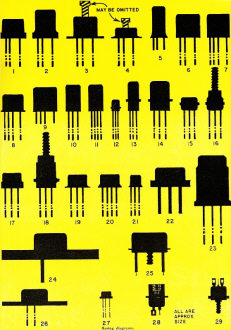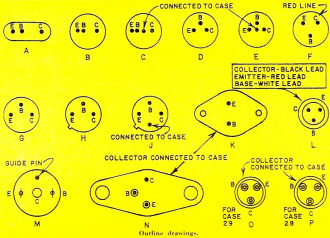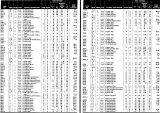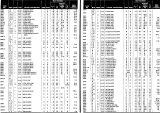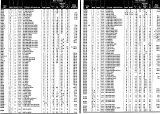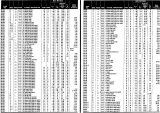Transistor Roundup |
|
When this "Transistor Roundup" article appeared in a 1961 issue of Popular Electronics magazine, the world was just getting serious about the transition from vacuum tubes to semiconductors. The slow take-up with solid state diodes and transistors was not simply a matter of not wanting or trusting the newfangled technology; it was also a practical matter of components being available which could be used in place of existing technology from both a performance and price perspective. In looking through the transistor parameter pages, the highest cutoff frequency I find is 800 mc (MHz), which was pretty good for the day, but most topped out in the tens of MHz. Power dissipation was a mere 75 mW, so that limited applications to low power oscillators, switches, and amplifiers. As we now know, within a decade semiconductors would completely replace tubes in new equipment except for high power and high voltage circuits. By the 1970s, there were some very high current devices being used in low frequency switching applications. Transistor Roundup Code Manufacturer 1 Bendix Aviation Corp. 2 CBS Electronics 3 Clevite Transistor Products 4 Delco Radio Div., GMC 5 General Electric Co. 6 General Transistor Corp. 7 Industro Transistor Corp. 8 Motorola Inc. 9 Philco Corp. 10 Radio Corp. of America 11 Raytheon Co. 12 Sprague Electric Co. 13 Sylvania Electric Prod., Inc. 14 Tung-Sol Electric Co. 15 Texas Instruments Inc. By James R. Spencer Have you ever thought of entering the challenging field of transistor circuitry, only to be discouraged by the thousands of types on the market today? Have you scanned the ads and sorted through stacks of manufacturers' spec sheets looking for just the right low-cost transistor for your circuit? Are transistors available that can give you needed watts of audio power? Are high-frequency transistors all high-priced? If these are your problems, "Transistor Roundup" will help you find the right transistor, at the right price. The directory distills over 2,000 manufacturers' transistor specification sheets into a listing of about 500 readily available low-cost transistors. Availability was the first consideration in compiling the list. All the transistors listed are in stock at most large electronics parts stores or can be ordered from large electronic parts mail-order houses. Price was the second consideration. Only transistors costing $5 or less are included. Bound by these two limitations, each transistor included was selected to provide the widest possible range of types, operating characteristics and case styles. Audio-frequency transistors included range from the microminiature low-noise hearing-aid amplifier 2N207 to the massive 2N1554 power amplifier. For radio-frequency applications, transistors are listed which operate from 455 kc (2N94) to 250 mc (2N588). For industrial control applications, a wide range of switching transistors has been included. Common transistor package pinouts. Transistor Parameter Tables Transistor Parameter Tables Type No. - Transistors are listed numerically according to their Electronic Industries Association (EIA) registration number. For some type numbers, A and B types are indicated as also being available. They usually have more closely controlled electrical characteristics and are generally more expensive than the price indicated in the third column. A "†" following the type number indicates the transistor is considered obsolete and not recommended for new equipment design. Mfr. - The manufacturers are coded numerically according to the following list. Where more than one manufacturer is given for a particular type number, the first one listed is known to offer the specific transistor in the price range indicated in the next column. The remaining manufacturers mayor may not offer it at the same price. Price - Because of regional and other variances, exact price is not quoted; the type number is indicated in one of three price ranges: *under 1, **from $1.01 to $2.50 and ***from $2.51 to $5. Type - To indicate biasing requirements, the type, n-p-n, or p-n-p, is given. N-p-n transistors require negative bias on the emitter and positive bias on the collector with respect to the base. P-n-p transistors require positive bias on the emitter, negative bias on collector. Typical Application - This column should be self-explanatory. Typical uses such as af amplifier, oscillator, driver, RF converter, mixer, if amplifier and many others are suggested. Case - The numbers in this column refer to the transistor case silhouettes which are shown about actual size. Base - The letters in this column refer to the basing diagrams. Many manufacturers connect one or another of the leads to the case structure, so the individual transistor specification sheet should be referred to before connecting the transistor into a circuit, especially for base diagrams B, G and H. Max Ratings - Three pertinent maximum ratings are given for each transistor: VCB, the maximum collector-to-base DC voltage in volts; IC, the maximum DC collector current in milliamps, or amps where noted; and the maximum collector dissipation in milliwatts, or watts where noted. These maximum ratings are absolute values which, if exceeded, will cause permanent damage to the transistor. hfe or hFE - hfe is the small-signal AC forward-current transfer ratio. hFE is the DC forward-current transfer ratio. In more common terms, they represent AC or DC gain. Typical values are given wherever possible. Alpha Cutoff Frequency - This is the frequency at which alpha (short-circuit emitter-to-collector current gain) is 0.707 of its low-frequency value.
Posted January 26, 2022 |
|

